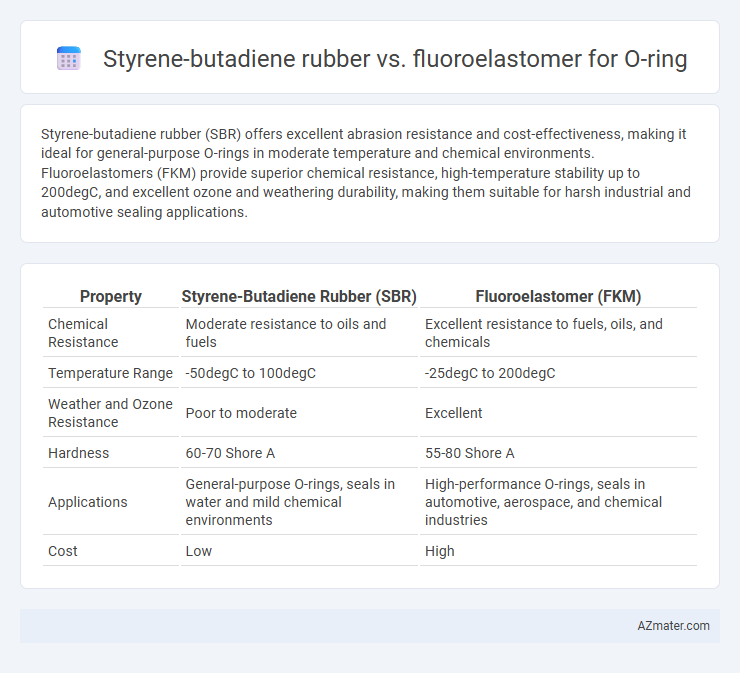Styrene-butadiene rubber (SBR) offers excellent abrasion resistance and cost-effectiveness, making it ideal for general-purpose O-rings in moderate temperature and chemical environments. Fluoroelastomers (FKM) provide superior chemical resistance, high-temperature stability up to 200degC, and excellent ozone and weathering durability, making them suitable for harsh industrial and automotive sealing applications.
Table of Comparison
| Property | Styrene-Butadiene Rubber (SBR) | Fluoroelastomer (FKM) |
|---|---|---|
| Chemical Resistance | Moderate resistance to oils and fuels | Excellent resistance to fuels, oils, and chemicals |
| Temperature Range | -50degC to 100degC | -25degC to 200degC |
| Weather and Ozone Resistance | Poor to moderate | Excellent |
| Hardness | 60-70 Shore A | 55-80 Shore A |
| Applications | General-purpose O-rings, seals in water and mild chemical environments | High-performance O-rings, seals in automotive, aerospace, and chemical industries |
| Cost | Low | High |
Introduction to O-Ring Materials
Styrene-butadiene rubber (SBR) offers excellent abrasion resistance and good aging stability, making it suitable for general-purpose O-rings in automotive and industrial applications. Fluoroelastomers (FKM), known for exceptional chemical resistance, high-temperature stability up to 250degC, and superior sealing performance, are ideal for O-rings in aggressive chemical environments and extreme conditions. Selection between SBR and FKM O-ring materials depends on operating temperature, chemical exposure, and mechanical stress requirements to ensure optimal durability and performance.
Overview of Styrene-Butadiene Rubber (SBR)
Styrene-butadiene rubber (SBR) is a synthetic elastomer widely used in O ring applications due to its excellent abrasion resistance and good mechanical properties. It offers moderate resistance to heat, ozone, and aging but has limited chemical and oil resistance compared to fluoroelastomers. SBR's cost-effectiveness and durability make it suitable for general-purpose sealing where exposure to aggressive chemicals is minimal.
Key Properties of Fluoroelastomer (FKM)
Fluoroelastomer (FKM) O-rings exhibit outstanding chemical resistance, particularly against fuels, oils, and aggressive chemicals, outperforming Styrene-butadiene rubber (SBR) in high-temperature environments up to 200-250degC. FKM offers superior compression set resistance, ensuring long-term sealing integrity in dynamic and static applications. Its excellent resistance to ozone, UV radiation, and weathering makes FKM ideal for demanding industrial and automotive sealing solutions where durability and reliability are critical.
Chemical Resistance Comparison
Styrene-butadiene rubber (SBR) exhibits moderate resistance to non-polar solvents, oils, and alkalis but degrades quickly when exposed to strong acids, ozone, and aromatic hydrocarbons. Fluoroelastomers (FKM), by contrast, offer superior chemical resistance across a wide range of aggressive fluids, including fuels, oils, acids, and solvents, maintaining integrity in temperatures up to 200degC. For O-rings requiring high durability in harsh chemical environments, fluoroelastomers significantly outperform SBR in resistance to swelling, cracking, and degradation.
Temperature Range and Thermal Stability
Styrene-butadiene rubber (SBR) offers a temperature range of approximately -50degC to 100degC, suitable for moderate thermal environments, but it exhibits lower thermal stability and degrades faster at elevated temperatures. Fluoroelastomers (FKM), such as Viton(r), provide a broader temperature range from -26degC to 205degC and exceptional thermal stability, maintaining performance in harsh chemical and high-temperature applications. The superior heat and chemical resistance of fluoroelastomers make them ideal for O-rings exposed to prolonged high temperatures and aggressive fluids where SBR would fail.
Mechanical Strength and Durability
Styrene-butadiene rubber (SBR) offers good mechanical strength with high abrasion resistance, making it suitable for applications requiring toughness and flexibility. Fluoroelastomer (FKM) excels in durability, providing superior resistance to heat, chemicals, and oil, resulting in extended lifespan under harsh conditions. When selecting O-rings, FKM outperforms SBR in maintaining elasticity and preventing degradation in aggressive environments.
Common Applications for SBR and FKM O-Rings
Styrene-butadiene rubber (SBR) O-rings are widely used in automotive tire manufacturing, conveyor belts, and general-purpose seals exposed to abrasion and moderate temperatures due to their excellent wear resistance and cost-effectiveness. Fluoroelastomer (FKM) O-rings are preferred in aerospace, chemical processing, and fuel system applications because of their superior resistance to high temperatures, chemicals, oils, and fuels. The choice between SBR and FKM O-rings depends on the required chemical compatibility, temperature range, and mechanical durability in specific industrial environments.
Cost Analysis: SBR vs Fluoroelastomer
Styrene-butadiene rubber (SBR) offers a significantly lower cost option compared to fluoroelastomer for O-ring applications, making it attractive for budget-sensitive projects. Fluoroelastomers, while more expensive, provide superior chemical resistance, heat stability, and durability, justifying their higher price in demanding environments. Cost analysis should weigh initial material expense against performance longevity and maintenance savings in specific industrial uses.
Environmental and Safety Considerations
Styrene-butadiene rubber (SBR) O-rings exhibit lower resistance to heat and chemicals, making them less suitable for high-temperature or aggressive chemical environments compared to fluoroelastomer O-rings, which provide superior chemical resistance and thermal stability up to 200degC. Fluoroelastomers are less prone to degradation and release fewer hazardous substances during use, enhancing environmental safety and reducing the risk of toxic emissions. However, SBR offers better biodegradability and lower production costs, which can be advantageous for applications prioritizing environmental impact and budget constraints.
Choosing the Right O-Ring Material for Your Application
Styrene-butadiene rubber (SBR) offers excellent abrasion resistance and cost-effectiveness, making it suitable for applications involving water, air, and mild chemicals, but it lacks chemical and heat resistance compared to fluoroelastomers. Fluoroelastomers (FKM) provide superior chemical, heat, and oil resistance, excelling in harsh environments with temperatures ranging from -20degC to 200degC, including automotive, aerospace, and chemical processing industries. Selecting the right O-ring material depends on the specific operational conditions such as temperature range, chemical exposure, and mechanical stress to ensure durability and optimal sealing performance.

Infographic: Styrene-butadiene rubber vs Fluoroelastomer for O ring
 azmater.com
azmater.com